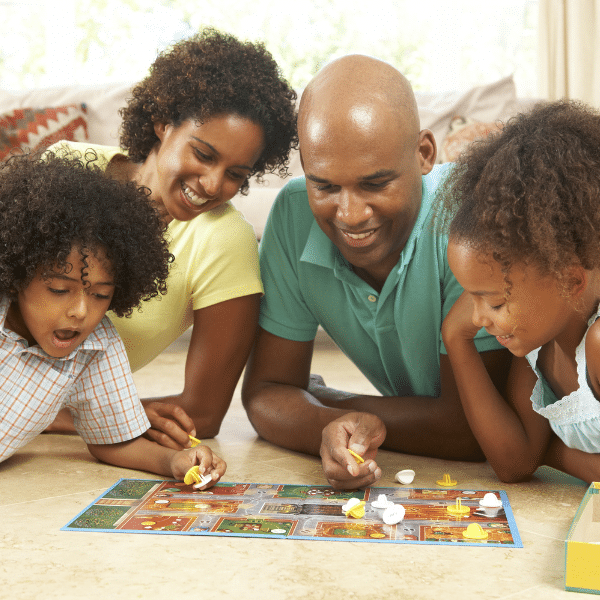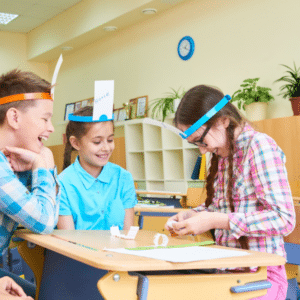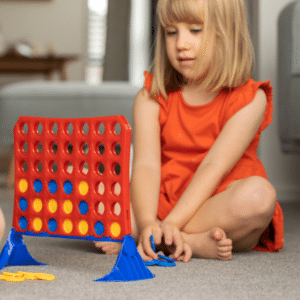Captivating Games to Play with a Deaf Child
By Sara Baines-Miller | Posted on: March 14, 2025

Ten Engaging Games to Play with Deaf or Hard of Hearing Children to Build Vocabulary and General Skills
When it comes to supporting the language development of children who are deaf or hard of hearing, incorporating fun and engaging games into their daily routine is a win-win. Games make learning enjoyable and provide natural opportunities to practice and expand vocabulary. Whether your child works on identifying new words, practicing sentence structure, or improving listening and spoken language skills, these games foster communication and connection.
In this article, we recommend games and activities that support learning with your deaf or hard of hearing child.
1 – Guess Who?
“Guess Who?” is a classic game that encourages players to ask questions to identify a character on their opponent’s board.
This game is particularly beneficial for practicing:
- Descriptive language: Children use adjectives and descriptors, such as “Does your person have glasses?” or “Is your character wearing a hat?”
- Yes/no questions: Practicing these types of questions helps with conversational turn-taking and clarity.
- Listening comprehension: Players must listen carefully to their opponent’s responses to narrow their options.
Pro Tip: To increase vocabulary development, introduce new descriptive words, like “beard,” “freckles,” or “curly hair,” and encourage the child to use them during gameplay.
2 – Heads Up!
“Heads Up!” is a fast-paced game where players guess the word displayed on a card held above their head based on clues from teammates.
This game promotes:
- Word association: Players learn to describe the word using related concepts. For example, if the word is “elephant,” clues might include “It’s a large animal,” “It has a trunk,” or “It lives in savannahs.”
- Expressive language: Children practice using full sentences to give hints.
- Critical thinking: Players must quickly interpret clues and make educated guesses.
Adaptation Tip: Create custom cards tailored to your child’s current vocabulary goals, such as categories like animals, household objects, or actions.
3 – Hedbanz
Like “Heads Up!”, “Hedbanz” involves guessing the word on a card attached to the player’s headband. The twist is that players ask questions to figure out what they are.
This game helps develop:
- Question formulation: Kids practice asking specific, strategic questions like “Am I an animal?” or “Can I be found in the kitchen?”
- Categorization skills: Players learn to group words into broader categories (e.g., food, animals, objects).
- Logical reasoning: Based on the answers they receive, players must deduce the correct word.
4 – Scattergories
“Scattergories” challenges players to come up with words in specific categories that all begin with the same letter.
This game supports:
- Expanding vocabulary: Players brainstorm unique words within various categories, such as “foods that start with S” or “items in the living room.”
- Word retrieval: Encourages children to recall and use fewer common words.
- Creative thinking: Kids learn to make connections and explore new vocabulary in a fun, competitive way.
Modification Idea: For younger children or those at an earlier language level, use more straightforward categories and allow multiple letters instead of one specific letter.
5 – Pictionary
“Pictionary” is a drawing-and-guessing game that’s perfect for visual learners. Players draw pictures representing words or phrases, and their teammates guess the answer.
This game enhances:
- Visual-to-verbal connections: Players link images to corresponding vocabulary words.
- Descriptive skills: Guesses often lead to further clarification and word exploration.
- Teamwork and collaboration: Players work together to interpret and articulate the drawings.
Modification Idea: Simplify for younger children by creating custom word lists that align with their current language goals.
6 – Taboo
In “Taboo,” players describe a word without using specific “taboo” words listed on the card.
This game encourages:
- Synonym generation: Players must consider alternative ways to describe the target word.
- Expressive language: Children practice using complete sentences and descriptive phrases.
- Listening and processing: Teammates must quickly interpret clues to guess the word.
Modification Idea: For younger players, create your own cards with easier target words and simpler “taboo” restrictions.
7- I Spy
“I Spy” is a versatile and travel-friendly game that can be played anywhere. Players take turns describing an object in their environment, and others guess what it is.
This game develops:
- Descriptive vocabulary: Kids use colors, shapes, sizes, and functions to give clues.
- Observation skills: Players learn to notice and describe details in their surroundings.
- Turn-taking: The game encourages patience and active listening.
8 – Bingo
“Bingo” can be customized with pictures or word cards to target specific vocabulary sets.
This game reinforces:
- Word recognition: Children match spoken words to corresponding images or written words.
- Listening skills: Players must focus on and process the caller’s words quickly.
- Repetition: Hearing the same words repeatedly during gameplay reinforces retention.
9 – Boggle
“Boggle” is a word game where players find as many words as possible by connecting adjacent letters on a randomized 4×4 letter grid within a time limit.
This game provides kids with:
- Spelling practice: Kids practice putting together multiple letters to make words within a timeframe.
- Time management skill building: Players adhere to a timer which forces the person to think and write quickly, encouraging time management and writing skills.
- Teamwork opportunities: Players, should they choose to team up, work together to come up with words.
10 – Connect Four
“Connect Four” Connect Four is a two-player strategy game. Players drop colored discs (often blue and yellow) into a grid. The goal is to be the first player to align four of the same color pieces in a row, column, or diagonal.
This game encourages:
- Strategy: Encourages players to be thoughtful in their decisions and anticipate future moves for themselves and their opponent.
- Patience: Playing games like Connect Four promotes patience. Sometimes, the decision for your or your opponent’s next move can take a while due to the strategy involved.
- Observation skills: Children must pay attention and observe their opponent’s next move. Not doing so could cost the player the game. This skill reinforces awareness and responsiveness.
Final Thoughts
Games like those listed in this article are powerful tools for language development, strategy training, teamwork, and patience building because they combine learning with play, creating an enjoyable and low-pressure environment. Whether you’re playing a board game, card game, or an activity on the go, the key is to engage in meaningful conversations throughout.
Remember to celebrate small victories, encourage creativity, and, most importantly, have fun! By playing these games regularly, you’ll see your child’s vocabulary and confidence grow in leaps and bounds.
Contact DePaul
If you’d like to speak with someone about our programs and services, please reach out! We look forward to chatting with you. In the meantime, happy gaming!
Share This Article:




